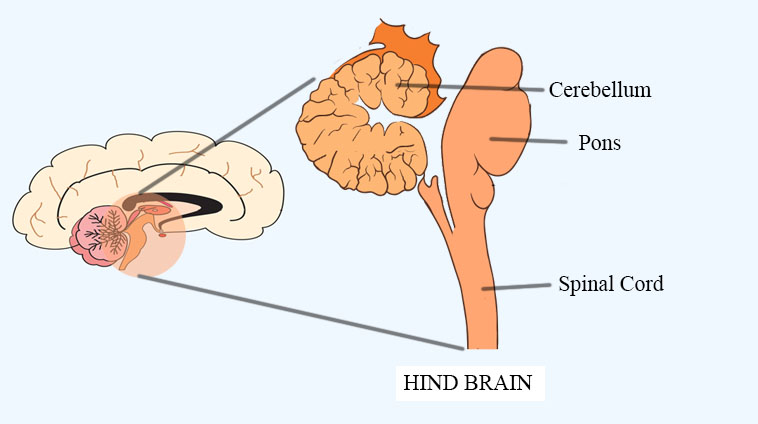
Cerebellum, medulla oblongata, and pons are part of
(a)Midbrain
(b)Hindbrain
(c)Forebrain
(d)Spinal cord
Answer
559.2k+ views
Hint: Brain is divided into forebrain, midbrain, and the hindbrain anteroposteriorly. Out of these the cerebellum, medulla oblongata, and the pons form the portion of the brain that coordinates functions that are fundamental to survival such as respiration, motor functions, sleep, and wakefulness.
Complete answer:
Cerebellum, Medulla Oblongata, and the Pons together form the posteriormost portion of the brain called the hindbrain. It is also called the rhombencephalon and supports vital body processes.
It is the portion of the brain that contains the origin or centers of all the cranial nerves from the trigeminal nerve(CN V) onwards.
Additional Information: The hindbrain or rhombencephalon further consists of metencephalon and myelencephalon.
The metencephalon is composed of the pons and the cerebellum and also has the origins of 4 cranial nerves CN V through CN VIII. It also has a portion of the fourth ventricle.
The myelencephalon comprises and forms the medulla oblongata in the adult brain. It also consists of a portion of the fourth ventricle and is the site of origin for CN IX through CN XII.
So, the correct answer is, “Hindbrain”
Note: -Pons and medulla oblongata of the hindbrain along with the midbrain form a structure known as the brain stem.
-This brain stem is the site of cardiac and respiratory centers and it regulates the heart rate and breathing rate.
-Out of the 12 pairs of cranial nerves, 10 of the pairs arise from the structures forming the brain stem.
-Brain stem also regulates the central nervous system and the body’s sleep cycle.

Complete answer:
Cerebellum, Medulla Oblongata, and the Pons together form the posteriormost portion of the brain called the hindbrain. It is also called the rhombencephalon and supports vital body processes.
It is the portion of the brain that contains the origin or centers of all the cranial nerves from the trigeminal nerve(CN V) onwards.
Additional Information: The hindbrain or rhombencephalon further consists of metencephalon and myelencephalon.
The metencephalon is composed of the pons and the cerebellum and also has the origins of 4 cranial nerves CN V through CN VIII. It also has a portion of the fourth ventricle.
The myelencephalon comprises and forms the medulla oblongata in the adult brain. It also consists of a portion of the fourth ventricle and is the site of origin for CN IX through CN XII.
So, the correct answer is, “Hindbrain”
Note: -Pons and medulla oblongata of the hindbrain along with the midbrain form a structure known as the brain stem.
-This brain stem is the site of cardiac and respiratory centers and it regulates the heart rate and breathing rate.
-Out of the 12 pairs of cranial nerves, 10 of the pairs arise from the structures forming the brain stem.
-Brain stem also regulates the central nervous system and the body’s sleep cycle.

Recently Updated Pages
Why are manures considered better than fertilizers class 11 biology CBSE

Find the coordinates of the midpoint of the line segment class 11 maths CBSE

Distinguish between static friction limiting friction class 11 physics CBSE

The Chairman of the constituent Assembly was A Jawaharlal class 11 social science CBSE

The first National Commission on Labour NCL submitted class 11 social science CBSE

Number of all subshell of n + l 7 is A 4 B 5 C 6 D class 11 chemistry CBSE

Trending doubts
Differentiate between an exothermic and an endothermic class 11 chemistry CBSE

10 examples of friction in our daily life

One Metric ton is equal to kg A 10000 B 1000 C 100 class 11 physics CBSE

Difference Between Prokaryotic Cells and Eukaryotic Cells

1 Quintal is equal to a 110 kg b 10 kg c 100kg d 1000 class 11 physics CBSE

State the laws of reflection of light




